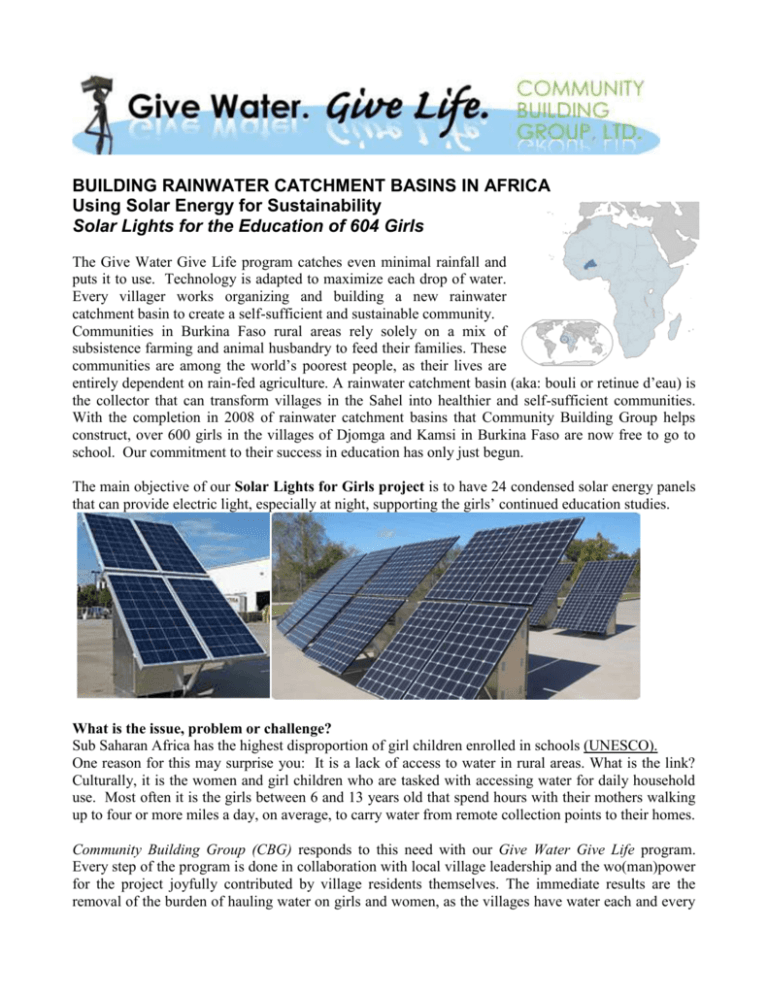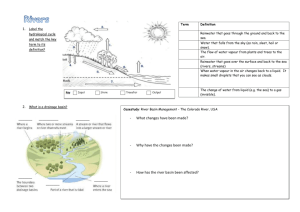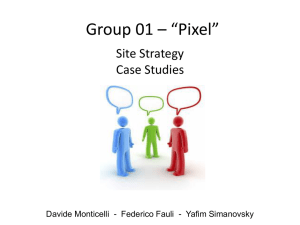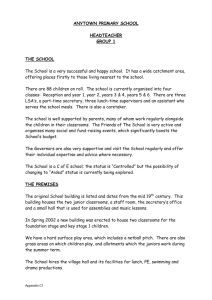(projdoc).
advertisement

BUILDING RAINWATER CATCHMENT BASINS IN AFRICA Using Solar Energy for Sustainability Solar Lights for the Education of 604 Girls The Give Water Give Life program catches even minimal rainfall and puts it to use. Technology is adapted to maximize each drop of water. Every villager works organizing and building a new rainwater catchment basin to create a self-sufficient and sustainable community. Communities in Burkina Faso rural areas rely solely on a mix of subsistence farming and animal husbandry to feed their families. These communities are among the world’s poorest people, as their lives are entirely dependent on rain-fed agriculture. A rainwater catchment basin (aka: bouli or retinue d’eau) is the collector that can transform villages in the Sahel into healthier and self-sufficient communities. With the completion in 2008 of rainwater catchment basins that Community Building Group helps construct, over 600 girls in the villages of Djomga and Kamsi in Burkina Faso are now free to go to school. Our commitment to their success in education has only just begun. The main objective of our Solar Lights for Girls project is to have 24 condensed solar energy panels that can provide electric light, especially at night, supporting the girls’ continued education studies. What is the issue, problem or challenge? Sub Saharan Africa has the highest disproportion of girl children enrolled in schools (UNESCO). One reason for this may surprise you: It is a lack of access to water in rural areas. What is the link? Culturally, it is the women and girl children who are tasked with accessing water for daily household use. Most often it is the girls between 6 and 13 years old that spend hours with their mothers walking up to four or more miles a day, on average, to carry water from remote collection points to their homes. Community Building Group (CBG) responds to this need with our Give Water Give Life program. Every step of the program is done in collaboration with local village leadership and the wo(man)power for the project joyfully contributed by village residents themselves. The immediate results are the removal of the burden of hauling water on girls and women, as the villages have water each and every day of the year. By securing access to water, girls can now go to school. Year round access to water in villages is a huge breakthrough. Rainwater catchment basins also help raise the water table so that wells within the village do not run dry. This is wonderful - while the sun shines – and what happens when the sun goes down? How do we help these girls get ahead and stay ahead with homework assignments and studies after dark? QUOTE: Celestine (3rd grader) “I study using a kerosene lantern.” Kerosene is costly for families that live way below the international poverty line and it is also a hazardous method of lighting for young children to manage. QUOTE: Fatimata (5th grader) “The light from the fire is what I use to study.” QUOTE: Edith (6th grader) “To study, I use a flashlight.” How will this project solve this problem? With the installation of twenty four Condensed Solar Panels at the two village sites of Djomga and Kamsi, locations identified by the community will receive light connections that can be shared by multiple households. A “Solar Girls Cooperative” will be organized in each village and will be responsible for the maintenance of the solar lights and will provide assistance to all residents in the use and management of solar power. In addition to this amazing breakthrough, two classrooms at the local schools in both villages will be electrified. With access to a clean supply of electricity, girl students can excel in revision and homework as they take advantage of extended study time beyond daylight hours. Potential Long Term Impact The Solar Lights for Girls project supports government’s long term plan to electrify rural communities to help bridge the gap between rural and urban service delivery and development. The children of the villages of Djomga and Kamsi will be the direct beneficiaries, but the villages as a whole will certainly benefit. According to the 2007 census, more than half of the inhabitants of the village of Djomga and Kamsi are female. Having access to electricity will lead to spin off benefits in industry and education for all people living here. QUOTE: Jean Claude, School Director: (see video): “Having light generated by solar panels will have tremendous positive impact on the students. We will study in the classroom how electricity is created using solar panels. Also, we will have classes for all villagers on the maintenance and upkeep of the solar panels. Our residents are very appreciative of the Give Water Give Life program, and we know improvements are more easily sustained with knowledge and hard work.” QUOTE: Chief, Village of Kamsi: (see video): “For two years, we have worked with the Give Water Give Life program personnel. Water year round is vital to our existence. All residents of Kamsi are working very hard to make sure we have a new basin, that all our children can attend school, and that we are successful. Having water and solar powered energy contributes to the long term sustainability of our community. We contribute to this endeavor and we thank all those that are also helping.” The socio-economic development of a society requires education. Educating the next generation of women leaders will ensure that the province and country will have productive citizens to build strong families and a strong nation. Give Water Give Life – General Program Information The detrimental impact of the lack of water availability cannot be overstated. When well designed, located properly, and constructed right, a basin collects and holds rainwater – providing water year round. Yes, water every day of the year is achieved by precisely locating the basin, which restores the water aquifer and raises the water table. With water available each day of the year, a basin empowers villagers to not only survive, but thrive. Improving Old Basins In addition, Give Water Give Life rebuilds collapsed rainwater collection ponds if the conditions are retrievable. Comprehensive engineering studies and water flow analyses are needed. Reconstruction also includes the use of satellite technology: determining the prime location in a village for a rainwater catchment basin is the key to restoring the water aquifer and raising the water table – which is how water becomes available every day of the year. Reconstruction requires building a new “weir”, an emergency spillway. A substantial spillway, using local materials such as large boulders wrapped in wire mesh and concrete, can be built with the villagers, and is necessary to sufficiently control and contain the water. Water from frequent short and heavy storms during the rainy season must be directed properly. The repair method can also be less costly than new basins. Past Success: In 2008, Give Water Give Life completed a 1.5 million gallon rainwater catchment basin in the village of Sisene, Bukina Faso. The endeavor took two years including organization, design and construction. Construction was conducted by local residents, which had the added benefit of stimulating the local economy. The water from the basin is utilized for irrigating farms & gardens, raising livestock, constructing bricks & buildings, fishing, reforestation, and business development. Moreover, in this region, rainwater catchment basins are the most effective, efficient and viable solution to drought, malnutrition and poverty. We intend to replicate this success in 100 villages over the next ten years. Effectiveness Your investment makes a difference in a cost effective manner allowing us to complete life-changing projects, such as the construction or substantial repair of a rainwater catchment basin at a relatively low cost; and solar powered energy for added sustainability! The Give Water Give Life Project team is based in Ouagadougou, Burkina Faso. GWGL has support from young engineers, students and external experts designing the water catchment basins in small villages in Burkina Faso. You are invited to contact us directly and contribute in any fashion. Additional Information: Laeticia Kaboré: kaborelaepol@gmail.com (+1226) 70.42.42.68 Seydou Traore: se73traore@gmail.com (979) 422.6312 Kathleen McDonald: kmcdon3107@aol.com (727) 515-0371 www.GiveWaterGiveLife.org








